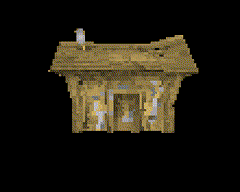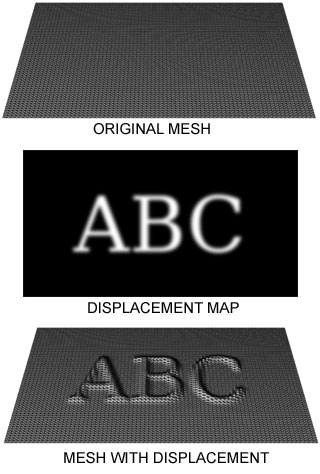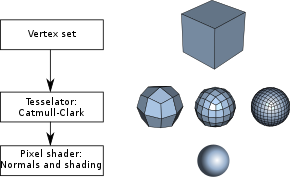
In computer graphics, rasterisation or rasterization is the task of taking an image described in a vector graphics format (shapes) and converting it into a raster image. The rasterized image may then be displayed on a computer display, video display or printer, or stored in a bitmap file format. Rasterization may refer to the technique of drawing 3D models, or the conversion of 2D rendering primitives such as polygons, line segments into a rasterized format.
Direct3D is a graphics application programming interface (API) for Microsoft Windows. Part of DirectX, Direct3D is used to render three-dimensional graphics in applications where performance is important, such as games. Direct3D uses hardware acceleration if it is available on the graphics card, allowing for hardware acceleration of the entire 3D rendering pipeline or even only partial acceleration. Direct3D exposes the advanced graphics capabilities of 3D graphics hardware, including Z-buffering, W-buffering, stencil buffering, spatial anti-aliasing, alpha blending, color blending, mipmapping, texture blending, clipping, culling, atmospheric effects, perspective-correct texture mapping, programmable HLSL shaders and effects. Integration with other DirectX technologies enables Direct3D to deliver such features as video mapping, hardware 3D rendering in 2D overlay planes, and even sprites, providing the use of 2D and 3D graphics in interactive media ties.

Texture mapping is a method for mapping a texture on a computer-generated graphic. Texture here can be high frequency detail, surface texture, or color.

In vector computer graphics, CAD systems, and geographic information systems, geometric primitive is the simplest geometric shape that the system can handle. Sometimes the subroutines that draw the corresponding objects are called "geometric primitives" as well. The most "primitive" primitives are point and straight line segment, which were all that early vector graphics systems had.

Crystal Space is an unmaintained framework for developing 3D applications written in C++ by Jorrit Tyberghein and others. The first public release was on August 26, 1997. It is typically used as a game engine but the framework is more general and can be used for any kind of 3D visualization. It is very portable and runs on Microsoft Windows, Linux, UNIX, and Mac OS X. It is also free and open-source software, licensed under the GNU LGPL-2.0-or-later, and was SourceForge.net's Project of the Month for February 2003. In 2019, one of the project's main developers described it as "effectively dead and has been for a good number of years".

In 3D computer graphics, normal mapping, or Dot3 bump mapping, is a texture mapping technique used for faking the lighting of bumps and dents – an implementation of bump mapping. It is used to add details without using more polygons. A common use of this technique is to greatly enhance the appearance and details of a low polygon model by generating a normal map from a high polygon model or height map.

Released in August 1997 by Nvidia, the RIVA 128, or "NV3", was one of the first consumer graphics processing units to integrate 3D acceleration in addition to traditional 2D and video acceleration. Its name is an acronym for Real-time Interactive Video and Animation accelerator.

In 3D computer graphics and solid modeling, a polygon mesh is a collection of vertices, edges and faces that defines the shape of a polyhedral object. The faces usually consist of triangles, quadrilaterals (quads), or other simple convex polygons (n-gons), since this simplifies rendering, but may also be more generally composed of concave polygons, or even polygons with holes.

In computer graphics, a shader is a computer program that calculates the appropriate levels of light, darkness, and color during the rendering of a 3D scene—a process known as shading. Shaders have evolved to perform a variety of specialized functions in computer graphics special effects and video post-processing, as well as general-purpose computing on graphics processing units.

A lightmap is a data structure used in lightmapping, a form of surface caching in which the brightness of surfaces in a virtual scene is pre-calculated and stored in texture maps for later use. Lightmaps are most commonly applied to static objects in applications that use real-time 3D computer graphics, such as video games, in order to provide lighting effects such as global illumination at a relatively low computational cost.
ATI TruForm was a brand by ATI for a SIP block capable of doing a graphics procedure called tessellation in computer hardware. ATI TruForm was included into Radeon 8500 and newer products.

Software rendering is the process of generating an image from a model by means of computer software. In the context of computer graphics rendering, software rendering refers to a rendering process that is not dependent upon graphics hardware ASICs, such as a graphics card. The rendering takes place entirely in the CPU. Rendering everything with the (general-purpose) CPU has the main advantage that it is not restricted to the (limited) capabilities of graphics hardware, but the disadvantage is that more transistors are needed to obtain the same speed.

In 3D computer graphics, polygonal modeling is an approach for modeling objects by representing or approximating their surfaces using polygon meshes. Polygonal modeling is well suited to scanline rendering and is therefore the method of choice for real-time computer graphics. Alternate methods of representing 3D objects include NURBS surfaces, subdivision surfaces, and equation-based representations used in ray tracers.
Direct2D is a 2D vector graphics application programming interface (API) designed by Microsoft and implemented in Windows 10, Windows 8, Windows 7 and Windows Server 2008 R2, and also Windows Vista and Windows Server 2008.
id Tech 6 is a multiplatform game engine developed by id Software. It is the successor to id Tech 5 and was first used to create the 2016 video game Doom. Internally, the development team also used the codename id Tech 666 to refer to the engine. The PC version of the engine is based on Vulkan API and OpenGL API.

A vertex in computer graphics is a data structure that describes certain attributes, like the position of a point in 2D or 3D space, or multiple points on a surface.

In 3D computer graphics, 3D modeling is the process of developing a mathematical coordinate-based representation of any surface of an object in three dimensions via specialized software by manipulating edges, vertices, and polygons in a simulated 3D space.

Displacement mapping is an alternative computer graphics technique in contrast to bump, normal, and parallax mapping, using a texture or height map to cause an effect where the actual geometric position of points over the textured surface are displaced, often along the local surface normal, according to the value the texture function evaluates to at each point on the surface. It gives surfaces a great sense of depth and detail, permitting in particular self-occlusion, self-shadowing and silhouettes; on the other hand, it is the most costly of this class of techniques owing to the large amount of additional geometry.
TeraScale is the codename for a family of graphics processing unit microarchitectures developed by ATI Technologies/AMD and their second microarchitecture implementing the unified shader model following Xenos. TeraScale replaced the old fixed-pipeline microarchitectures and competed directly with Nvidia's first unified shader microarchitecture named Tesla.
This is a glossary of terms relating to computer graphics.













